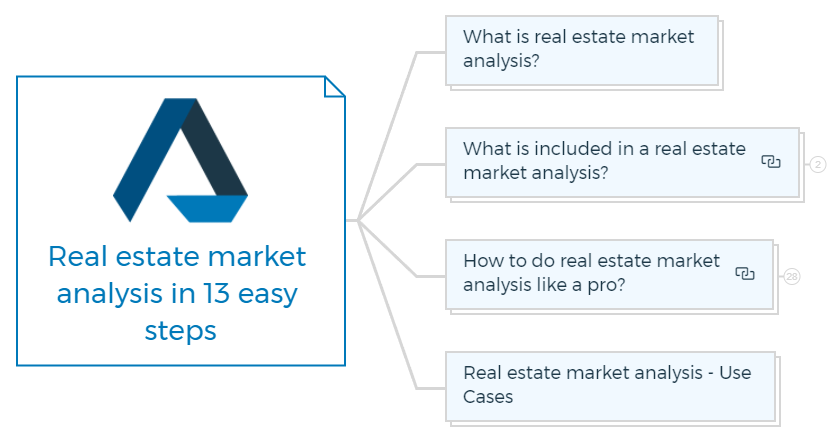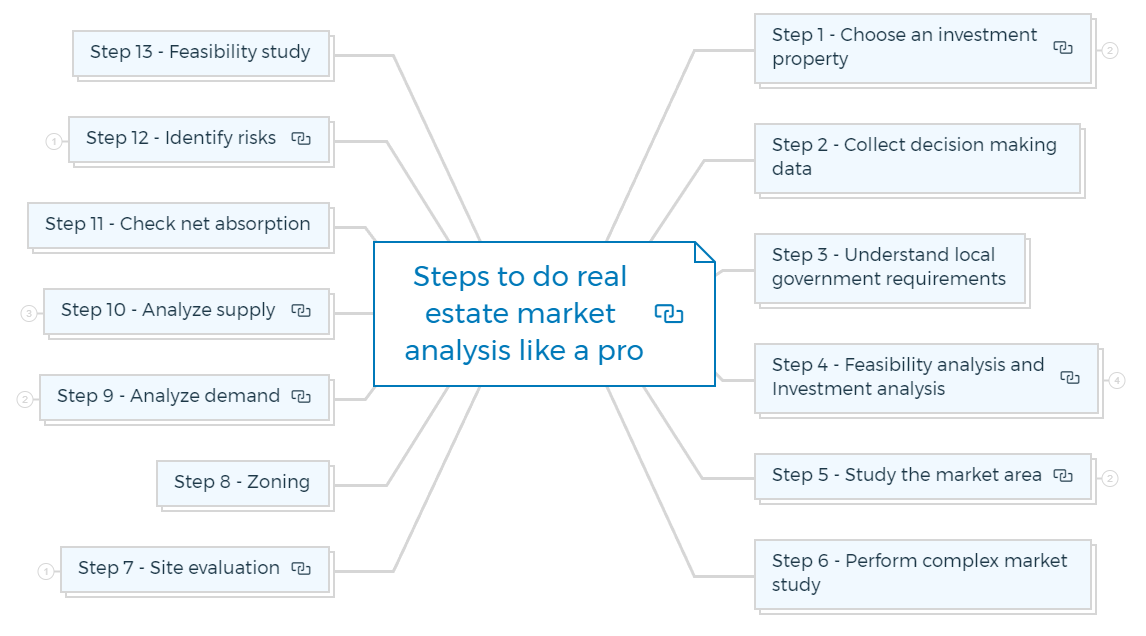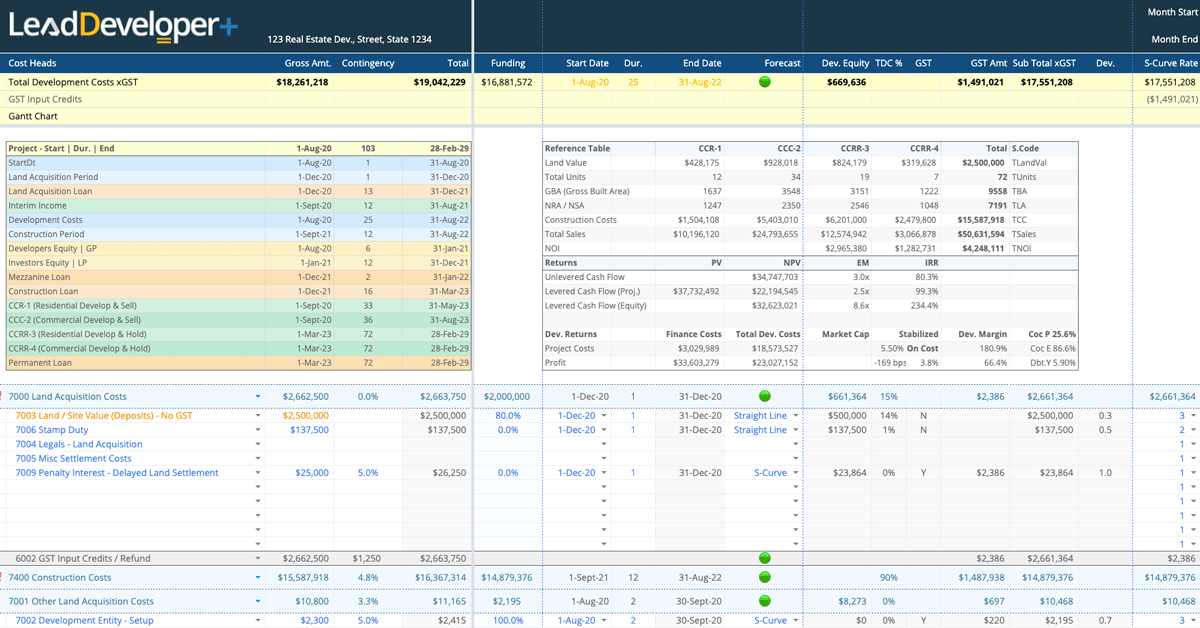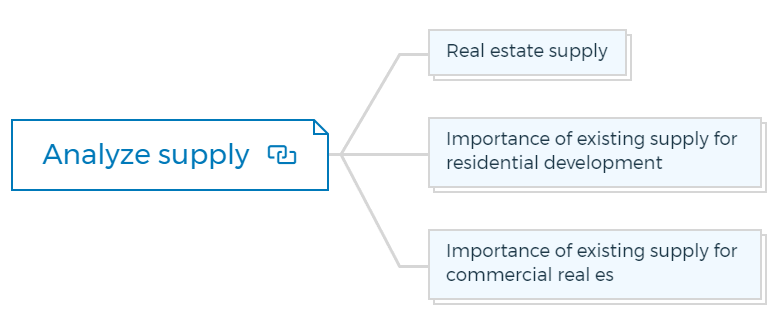Steps to real estate market analysis

What is real estate market analysis?
Real estate market analysis, also known as comparative market analysis, is the process of evaluating and forecasting real estate markets to make sound investment decisions.
It is a key component of real estate investing, and there are a variety of methods that can be used to conduct a real estate market analysis.
The most important part of any comparative market analysis is data collection, so ensure you have accurate and up-to-date information on all aspects of the real estate market.
It includes site-specific and local factors, as well as current and emerging competition.
In simple words, you will be evaluating the current market value of properties that are similar to the one you are considering purchasing or selling.
What is included in a real estate market analysis?

1. Market study
- Local economies analysis - Examines the fundamental factors determining the demand for real estate in a specific market.
- Real Estate Market analysis - Examines the demand and supply of a specific property type in the market.
- Marketability analysis - Examines a specific development or property to determine its market competitiveness.
2. Studies based on individual decision
- Feasibility Study Analysis - Assesses whether a particular project is likely to be financially viable and appropriately implemented if pursued under a proposed programme. It's related to develop-ability, financial feasibility and investment analysis.
- Real Estate Investment Analysis - Also known as real estate proforma, which analyses a property to determine if it is a good investment. It includes modelling various timelines and or financing options to determine the best financial outcome under various assumptions.
Your real estate market Analysis should answer three key questions:
- Is there a demand for the type of product you are developing?
- What rent/price can you charge for your project, and how quickly will the market accept the project?
- How can the project be planned and marketed to increase its marketability?
How to do real estate market analysis like a pro?

Step 1 - Choose an investment property

Start with location
The first step of your real estate market analysis should be finding a location of a particular property, whether residential, commercial or industrial, which will determine its value.
Location analysis is performed based on improvements, zoning and competition. It also considers the availability of similar properties.
Determining the property's market value
There are many theories and methods available. Some use inaccurate statistical bases; others use local trends or regional trends.
It is impossible to determine the market value of real estate purely based on visual inspections and other non-fundamental indicators. These selections should be made after a thorough comparative analysis of all real estate markets.
The following questions pose challenges for real estate investors performing market analysis:
- What are the factors that determine a fair market value of a property?
- What is the best way to compare properties of similar types?
- How much does an investment property cost?
Analyse the collective economic, demographic, and local factors that affect real estate values.
Step 2 - Collect decision making data
The data collection should be viewed as competitive intelligence. For all sorts of data, the analyst must consider bias.
Raw data, also known as primary, is unanalysed and collected by the analyst. This could include reading classified ads, new development announcements, legal notices and census data. Secondary data is data analysed by someone else, who then tells the analyst to conclude.
On the demand side, the analyst should consider the following factors:
- Population
- Household size
- Demographic features
- Purchasing power
- Income
- Affordability
- Purchasing power
- Employment statistics
- Migration
- Commuting patterns
The following items are included in determining the supply side.
- Available space inventories.
- Vacancy rates and the existing property inventory's character.
- Recent space absorption, including the sorts of tenants or buyers.
- Projects that are now being built or are in the pipeline.
- The differences in market rents/sale prices by location and quality.
- Existing and projected projects' features, functions, and benefits.
- Concessions and terms.
The number of information sources available is also not limited. Newspapers, census and private databases, tax rolls, advertisements, and maps, etc. Any source that discloses something of interest—may be used by analysts.
The real estate market analyst may interview brokers, owners, planners, and local officials. The purpose of the interview is to gather as much information as possible about the market.
Step 3 - Understand local government requirements
The analyst must be familiar with the local government. The government is your largest partner in the real estate business.
If you want to conduct a project, you must first grasp how the political structure supports or inhibits your project. This includes understanding zoning laws, building codes, and other regulations that may impact the real estate market.
Almost everyone in the real estate industry conducts market research:
Analysis from private sources
- Appraisers / Property Valuers
- Real Estate and Financial Brokers
- Real Estate Developers
- Real Estate Investors
- Lenders and asset managers.
Analysis from public sources
- Urban & town planners
- Consultants in economic development
- Governmental organisations.
Market analysis is utilised in the private sector to increase profitability (and reduce losses by reducing market risks). On the other hand, the public sectors often include a framework of repercussions beyond economics or feasibility, such as density, traffic, or design.
Step 4 - Feasibility analysis and investment analysis


Feasibility study will help you determine if the investment property is a good fit for your investment goals. The feasibility study should include a detailed analysis of the costs and benefits of the investment.
The feasibility analysis process is designed to see if the numbers add up given current perceptions of how a project should go, how much it will cost, and who will buy or rent the property.
Investment analysis is a related technique that looks at the same financial questions from the investor's perspective.
Feasibility - often linked with developers and project management—is a component of market analysis for developers, whereas investment analysis explores the same concerns with a different set of options.
A developer may compare various projects, sites, and real estate markets; similarly, an investor may compare potential real estate investments against non real estate alternatives.
Funding factors will, of course, be reviewed by the investor as part of the research; nevertheless, financing is not limited to investors.
Lenders and potential lenders will conduct various investment analyses to assess risk and choose the best type of property development financing.
Market analysis is essential for a real estate project's first feasibility assessment, but it doesn't end there. Throughout the project's development and management phases, market research plays a significant role in creating the project.
Market experts are frequently contacted for repositioning measures after a project is up and going and the developer finds that absorption does not meet predictions.
There are as many different types of market analysis as there are different sorts of development initiatives, stages of development, and interests served.
Market analysis includes:
- Determining the timing for demand.
- Analysing the direct relationship between demand and supply (which should consider the role of competition).
- Calculating investment rates of return
Market study vs Feasibility study
What is market study?
Market study focuses on three main areas of evaluation: the location, the demand for the product, and the supply of comparable items. Answering specific issues posed by lenders, equity partners, or investors should always be the crucial step in any market study.
Factors affecting the cost of market study
- Complexity of real estate market
- Data availability
- Methodology used
- Number of properties studied
- Size of real estate market
- Time frame of study
- Type of real estate market analysis
The difficulties of location and supply and demand analyses lead to a series of essential questions:
1. Is there sufficient demand for the existing or projected upgrades to ensure that vacancies are kept to a minimum? This should include demographic analysis, as well as income, employment, and growth projections.
Price segmentation and coordination with marketability may be additional market components beyond supply and demand analysis.
2. Is there a market for such advances, and if so, how easily can the development be sold? What effect would the proposed development have on present supply in the nearby area (local market) and the broader market (regional market)?
3. How will the development be funded, and where will the money come from?
Tenants, real estate acquisition/sale, and financing are three types of supply and demand that I recognise.
A real estate market analysis will also include the following questions, which are more concerned with marketability than with market conditions:
4. What are the current competitive developments, and how should this project be conceived, planned, and marketed to compete effectively? To put it another way, what is the unique development concept in terms of the site plan, architecture, design, and the target market (tenant, shopper, or user)?
5. What essential elements influence your market analysis?
The market study revolves around these five points, which include supply and demand issues.
A feasibility study concentrates on the financial implications of a proposed development or acquisition. Property Development Feasibility is based on three things:
- A location looking for a use
- Employ in site search
- An investor looking for a way to become involved.
Market analysis and feasibility study Should Include...

While the study paper has no defined format, a typical real estate market analysis will include the following items:
Cover page: It includes the type of study, property address, and team members.
Letter of transmittal: Major findings and conclusions.
Table of contents: A listing of all sections.
Nature of the project: Description of the project, techniques, strategies, approaches used, and the extent of services provided.
Economic context: Defines the market framework; first examines the more significant market areas (i.e., regions or cities) before moving on to the smaller market areas (i.e. neighbourhoods).
Analysts must consider all factors, including sociological, economic, governmental and political.
Property description and proposed development: It includes a separate description of the site and its improvements. This section outlines the proposed site's physical and economic strategy.
Competitive developments: While the economic backdrop part will give market statistics on the competitive supply, this section should include facts on the development's most significant competitors.
It should include rental rates and selling prices, vacancy rates, project sizes, and other data.
Market potential: In this section, the analyst determines how well the planned development will capture demand in light of the economic backdrop and comparison to competing developments.
This is where you may calculate the development's demand. Where does the demand for the suggested plan come from? What makes your plan unique or similar to the competition?
The conclusion of the marketability: This report should not include any new information. This section is devoted to pure analysis. So far in the report, everything has been considered regarding how the projected development would compete.
Addendum: Any supporting papers, such as site plans, maps, and information that supports other portions of the report, are placed in this section.
Exhibits: Include valuable additional items, such as a map identifying the location of the subject, competitive developments, and the market area.
It also includes photographs of the subject property, its block front, the block facing it, and competition schedules in specific sections or as an appendix.
The differences between the two types of research show a wide variety of needs for thorough real estate market analysis.
A key distinction to keep in mind is that a market study may remain most relevant for a long time. In contrast, a feasibility study is more likely to adapt as financial realities change, such as employment, building and land costs, and other economic data.
Get The Edge Now!
Discover the transformative power of our FREE EDGE platform and
unlock a world of opportunities at no cost!

Your Real Estate Toolkit Awaits!
Free eBooks, Courses & Feasibility Suite Trial—Join Today!
✓ Unlimited FREE Trial: Experience the full power of our Feasibility Suite with hands-on demos
—explore without limits, no time pressure & without commitment or credit card!
✓ Learn from Success: Dive into real-life case studies for practical insights.
✓ Engage, Inquire, and Innovate: Ask questions, request features, and engage in lively discussions.
✓ Showcase Your Projects and Gain Insights: Share your projects and get personalised feedback.
✓ Free Resources Galore: Access a treasure trove of free resources,
eBooks & courses to keep you informed.
✓ Exclusive Training: Enjoy members-only training to sharpen your skills.
Step 5 - Study the market area
Many real estate investors overlook the significance of market research and site evaluation. The most critical aspect of considering a real estate investment is to study the market area.

An overview of the real estate market area
A thorough real estate market analysis usually leads to market research, but what format does this report take?
An organised market study prepared logically is beneficial to the reader (whether approval-granting authorities, equity partners, or lenders). This way, the information gives a clear image of the market in all of its meanings, and one can discover meaningful information to make judgments quickly.
Your market area study report should emphasise and explain four critical areas of evaluation:
- The overall market area
- Location-specific factors
- Demand factors
- Supply of comparable properties
These four sections of the market study are meant to prompt crucial questions.
For example, if you can show that the market region, location, demand, and supply factors all favor advancing, it will make sense to others. Equally essential, if you can't build a convincing argument for the idea during the market analysis, why would anyone else want to go ahead with it?
Geographic information systems | Spatial analysis
A study of the market area is the starting point. It is the area where supply and demand are active.
Traditionally, market areas have been assessed by physically inspecting the land. New technology, on the other hand, has broadened the possibility of a market area analysis.
The emerging geographic information systems (GIS) technology, or electronic mapping, empowers real estate decision-makers from relying on arbitrary boundaries.
This new technology allows the analyst to examine geographic data from a genuinely global perspective. In many cases, artificial barriers do hide the actual market region.
A retail shopping mall, for example, would be constructed to service a specified population and geographical market region, allowing fair predictions about traffic volume and potential sales to be made.
However, a thorough examination of the market region may reveal that the outcomes are not always as evident as they appear at first glance.
Step 6 - Perform complex market study
You might want to figure out the regional facts that define the potential market. Geographic Information Systems (GIS) is the latest tool that you can use for more complex market area research.
These systems can include any database that can indicate a geographic location or spatial dimension for the variables.
GIS would almost certainly discover important insights for similar project studies in any modern market area investigation. Aside from the geographic location of a perceived market, additional market assessments may be required.
Here are some guidelines
- Determine the region not just in terms of geography but also in terms of where the market is located.
The market area for tenants can include both the immediate neighbourhood and adjacent areas. For example, this could be related to employment placement and access to transit lines in residential real estate projects.
- The study of any project should take into account how the new project may affect existing projects.
Be mindful of the distinctions between artificial boundaries (county lines, state borders, etc.) and built limits (freeways, etc.) that define or restrict a market region.
Be aware of the historical patterns of development that are based on cultural or ethnic ties. While these boundaries may change over time and evolve, they remain remarkably constant.
Make cautious assumptions about the optimum scale of development or the size of an existing market region based on unverified assumptions. It is crucial to examine the initial assumptions critically and test the conclusions.
Step 7 - Site evaluation
The characteristics of one location differ significantly from those of another, and the explanations are not always clear.
The characteristics of a region have an impact on the conclusions. An interstate highway, a major border crossing, or employment patterns in one city or region, will have a substantial impact on your market analysis.
This leads to the significant real estate market analysis step, which is a more detailed site assessment.

What's includes in the site evaluation?
Physical variables such as terrain, land shape, adjacent usage, and proximity to essential services should all be compared from site to site in a site evaluation.
Comparative analysis allows you to evaluate a specific property or a set of potential sites while keeping certain attributes in mind.
A shopping mall near a freeway exit would, of course, have more potential than one located outside of the city limits and away from the visibility of potential shoppers, the ease of access via roads and transit stations and the overall practicality of placing a shopping mall on well-travelled routes.
When comparing residential properties, local transit and proximity to amenities such as schools and retail are essential factors to consider. The analyst must walk the site, even if it may seem obvious to some.
Step 8 - Zoning
The issue of zoning should not be disregarded while doing a site examination. We can't just assume that a rezone will automatically be granted because the land has been purchased for a specific purpose.
Lower-priced property may be so priced because of its current zoning, and local governments (not to mention individuals living nearby) are unlikely to support a rezone solely for the convenience of development interests (and profit).
On the other hand, if the new project will benefit the community and local government through more significant tax revenues, rezoning approval may be pretty easy to get.
One risk aspect in the site appraisal is the possible complications of investing in the land when zoning issues develop. You may need to compare undervalued but possibly lucrative land to more prominent locations.
Although the cost of already-zoned commercial land is likely to be higher, the likelihood of public anti-growth campaigns or refusal of rezoning applications by local governments is greatly reduced when zoning concerns are not discussed.
It's critical to review state and municipal regulations beyond zoning for site appraisal. The zoning is worthless if you won't get approval for your project due to GMA regulations because the site is outside the UGA.
As a prerequisite for approval, growth management regulations may require you to demonstrate the need for the development you propose.
For instance, you may need to assess a site in the context of a county's inventory of land with similar zoning. How much of that land has been developed and is in use?
In GMA states, you may need to limit your site evaluation to available property within the existing urban perimeter or be prepared to show the need for your development outside that border.
Step 9 - Analyze demand

Economic demand
Consumers need and want more of a commodity or type of outlet (shopping centres, apartments, houses, etc.) or when that demand is likely to follow if and when the development occurs.
For example, a hamlet may be 60 miles from the nearest large-scale regional mall. The lack of such a mall in town does not indicate a lack of demand. If such a facility was to be created, it is logical to assume that shoppers would arrive immediately rather than going 60 miles.
As a result, a demand analysis must contain understanding and analysis of real estate market forces and trends, but this is not always the case. You might also see a more politicised notion of demand.
In some instances, the actual objective is to prevent change in any form; in that case, zoning and municipal code requirements may not be adequate to have your proposal approved.
You may need to include the local political demand for development in your demand analysis.
Political demand
Political demand in some jurisdictions is nil. From a development standpoint, the project may not be feasible due to politics, regardless of the economic demand.
This issue is widespread, but the breadth of issues linked with anti-growth sentiment in residential development (particularly against low-income housing) is severe.
Slow growth policies may ultimately demonstrate that when the government attempts to limit growth, it creates poorly planned growth and cannot prevent it.
Step 10 - Analyze supply
The concept of supply is complicated in areas where legislation has been drafted to regulate or prevent growth.
Supply is clearly known in economic terms. It refers to the features that are available for a given purpose. Prices will soften when economic supply is high, and demand is low.
When there is a shortage of supply and high demand, prices rise. This fundamental economic notion is not difficult to grasp, at least in its theoretical definition.

Learn More
Real estate supply
Real estate supply is divided into three categories: completed, under construction, and projected. The real estate market analyst should discount the variables because each has a distinct level of reliability.
Developers, for example, may propose a project for which they have no tenants to frighten off other developers or lure a possible tenant into driving the development.
Most downtown office buildings cannot be completed or financed without a committed tenant. As a result, it's usual for developers to proclaim construction as a marketing technique rather than a statement of fact.
In a written market study, an economic analysis may limit the supply and demand issues. Those economic evaluations are perfectly appropriate if one conducts the market analysis to persuade lenders of a project's profitability and cash flow strength.
The same holds when a study is aimed to attract equity partners or get clearance for tax credits in low-income housing.
However, if a real estate market analysis aims to assess whether a project is economically and politically viable, you must look beyond the economic version of supply.
Importance of existing supply for residential development
Anti-growth conflict is frequently linked to supply issues in residential developments. Anti-growth forces may claim that there is a sufficient supply of housing and that new construction is unnecessary.
Even when economic demand is apparent, you may face this argument.
On the other hand, the anti-growth argument persists: more people will migrate if you build more houses.
This entails increased traffic, more crime, the need for better roads, larger schools, and other growth-related disadvantages. As a result, supply may become a necessity rather than a simple economic analysis of whether enough purchasers are available.
Importance of existing supply for commercial real estate
The issue of supply is equally complicated in commercial developments. A real estate market study would examine purchasing habits, traffic patterns, logistics, and site-specific questions to persuade the research's reader that, for example, a mall will succeed at a specific location.
This analysis would include commercial vacancies that might be influenced by changing traffic and shopping habits, local and regional rivalry, and average rental rates in the area.
Step 11 - Check net absorption
Determining the demand for residential or commercial developments requires a study of the trend in net absorption. In the case of single-family houses, there has been a need for real estate sales patterns in recent months.
The square footage/meterage of available space modified by vacancy levels is known as net absorption.
Net Absorption = Space Occupied - Space Evacuated + Space Demolished - New Space Construction
Step 12 - Identify risks
Identifying risk is an element of the feasibility study process in real estate market analysis —and is critical for the lender or investor.
This risk can manifest itself in various ways, not only in the most obvious ones like a net loss or negative cash flow.
In some instances, a considerably more concerning risk is that the initial funding will not be sufficient to complete the project. The feasibility study shows a hypothetical depiction of what will happen during the project's acquisition, development, completion, tenancy, and eventual sale.
What if the initial funding or equity investment isn't sufficient to accomplish these steps? Where will the extra funds come from? Of course, the study's attempt to depict how existing facts might appear in the future—in other words, a forecast—should be considered one of many possible results.
Methods of risk analysis
There are a variety of methods that can be used to identify risks in real estate. Some common methods include:
Fundamental analysis: This method looks at the underlying economic factors that impact real estate markets, such as population growth, job growth, and interest rates.
Technical analysis: This method looks at historical data to identify trends in the real estate market.
Property specific analysis: This method looks at specific characteristics of an investment property, such as its location, age, and condition.
Market analysis: This method looks at the overall real estate market to identify risks and opportunities.
Step 13 - Feasibility study
While the subject of feasibility is primarily a financial one, it is much more than that. The usual accounting revenue estimate, cost and spending plan, and cash flow projection are confined to documenting potential outcomes.
The feasibility study, on the other hand, is significantly more. Although it is mainly financial, it should be fascinating in ways that go beyond the numbers.
A lender examining a feasibility study should determine whether or not the risk of financing the project is acceptable.
Feasibility does not show an attempt of no risk; a potential lender or equity partner would not accept this premise, and such a claim would be unsupported by any standards.
On the other hand, the risk issue will be on the minds of everybody approached by developers for funding or investment.
In its most basic form, feasibility is a combination of a budget and a disclosure statement. It should be viewed as part of a test of financial potential, risk, and required finance.
A part of due diligence, all of this is used to examine the project's fundamental assumptions. In light of this risk, the feasibility study must cover the financial risk in great detail.
The feasibility study serves as a risk disclosure summary during the due diligence process as a planning document.
It should be based on market research. The disclosure must be based on market assumptions; thus, a feasibility study cannot begin before a market test.
In broad strokes, real estate market analysis answers this one question:
Does it make sense to play in this market, given the site issues, supply and demand, and competition?
In comparison, the feasibility study should address the following question:
Can you afford to build the project as initially planned, or do you need to assess expenses in light of market and financial factors?
Market research indicates the best way to complete the project in scope and size (and thus, cost). As a result, the market analysis informs the feasibility study's assumptions.
That is the entire assumption base for analyzing risks and assessing whether a lender can reasonably expect regular payments or an investor can reasonably expect a return and, eventually, a profit.
Real estate market analysis - Use cases
Should market research be conducted to secure financing only? The market and feasibility studies are necessary for acquiring funds for a project, but is that the end of the procedure?
In reality, real estate market analysis and the information gleaned from it are helpful planning tools. The architect, engineer, and project planning team can and should use these throughout the project.
The individual or firm preparing research examines population, income, employment trends, commute and traffic patterns, and other factors when generating the raw material.
You can use this document to give vision and direction to all those involved in making the project a reality.
Much focus is placed on a project's marketability, either in terms of rental cash flow or how to optimise market value if the developed property is to be sold. However, a marketability study is only a small element of real estate market analysis as a whole.
The latter is beneficial when it incorporates components of the market study and feasibility study. However, it is even more powerful when the material and conclusions are presented to convey the crucial project vision.
Community involvement, municipal planning, innovative design, sensitivity to local issues, and the project's practicality in every aspect, not only in terms of financial success, are all part of that vision. Because no two projects are alike, market analysis is crucial to a project's local acceptance.
Any attempt to construct initiatives using a cookie-cutter approach would almost certainly be met with resistance. Style, site layout, and price range should all be determined by a list of local characteristics.
Citizen participation and opposition to the development, local political atmosphere, and the far more concrete site-specific qualities, such as topography, closeness to traffic patterns, and adjacent zoning, are just a few examples.
The most influential real estate market analyses meet the needs and answer the questions of each of the interested parties. This includes lenders or equity partners, developers or contractors, architects and designers, marketing interests or users, and local real estate agents.
Control profit on any property with this free Property Development Feasibility Study Bundle.
FAQs

